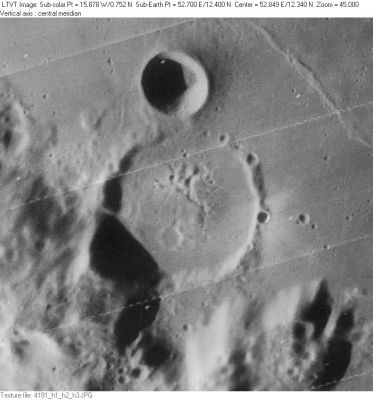Greaves
Contents
[hide]Greaves (in the southwestern part of Mare Crisium)
(formerly Lick D)
|
Lat: 13.2°N, Long: 52.7°E, Diam: 13 km, Depth: 2.41 km, Rükl: 37 |
LO-IV-191H Greaves is the bowl-shaped crater at the top of the frame, with the large ghostly ring of Lick south of it. Ruined 23-km Lick A is partially visible just below Lick. The wrinkle-ridge in the upper right is not part of any named system.
Images
LPOD Photo Gallery Lunar Orbiter Images Apollo Images (see: Lick D)
- A fully illuminated Greaves (Lick D) was captured in Apollo 17's panoramic ITEK camera frame AS17-P-2687. You can't miss Greaves because here it is the most eye-catching formation!
- Greaves was also captured in Apollo 17's oblique south-looking Mapping/ Metric Fairchild camera frame AS17-M-1639 (rightward of the frame's centre).
- Additional research: Danny Caes
Maps
(LAC zone 62A1) LAC map Geologic map LM map LTO map
Description
Description: Wikipedia
Additional Information
- Depth data from Kurt Fisher database
- Westfall, 2000: 2.41 km
- Viscardy, 1985: 1.96 km
- The shadow in Greaves indicates a depth of about 2500 m. - Jim Mosher
Nomenclature
- William Michael Herbert Greaves (10 September 1897 – 24 December 1955) was a British astronomer. He is most noted for his work on stellar spectro-photometry.
- This replacement name for a formerly lettered crater was introduced on LTO-62A1. - Jim Mosher
LPOD Articles
Bibliography
